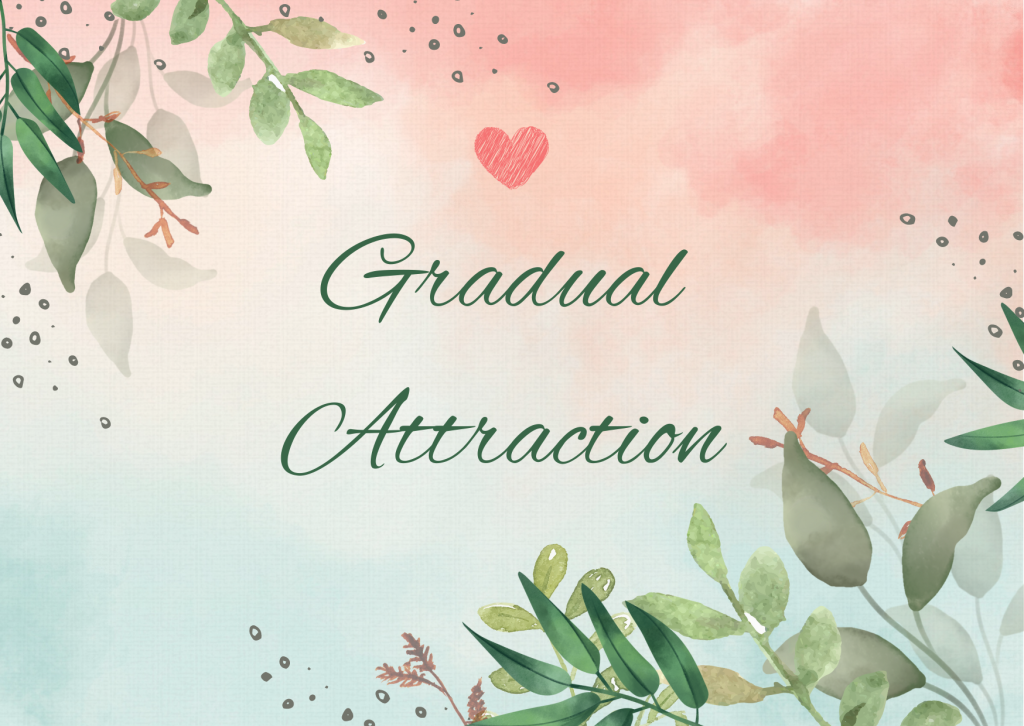Introduction: Understanding Different Paths to Love
Love is a complex and multifaceted emotion that can manifest in various ways. While some people experience love at first sight, others find their feelings develop gradually over time. Understanding these different paths to love can help you navigate your relationships more effectively and recognize your own preferences. This article explores the concepts of love at first sight and gradual attraction, helping you determine which one resonates with you.

Defining Love at First Sight
Characteristics of Instant Attraction
Love at first sight is often described as an immediate and intense connection with someone upon first meeting them. It’s characterized by a strong physical and emotional attraction that feels almost magical. People who experience love at first sight often report feeling an instant bond, a sense of familiarity, and an overwhelming desire to know more about the other person.
You might feel a surge of adrenaline, your heart might race, and you might find it hard to look away from the person. There is often an inexplicable magnetism that draws you towards them, making you feel like you’ve known them forever.
Psychological and Biological Factors
The phenomenon of love at first sight can be explained by a combination of psychological and biological factors. Psychologically, our brains are wired to make quick judgments about potential partners based on physical appearance, body language, and other non-verbal cues. Biologically, the release of chemicals such as dopamine and oxytocin can create feelings of euphoria and attachment, contributing to the sensation of instant love.
Studies have shown that our brains can process visual cues and make snap decisions about attractiveness in just milliseconds. This rapid assessment involves subconscious calculations about health, fertility, and genetic compatibility, which are critical for survival and reproduction.
Common Experiences and Stories
Many people have shared their stories of love at first sight, describing how they knew they had met “the one” within moments of seeing them. These stories often highlight the intensity of the initial encounter and the deep emotional connection that followed. While love at first sight may seem like something out of a fairy tale, it is a real experience for many individuals.
For example, Jane and Mark met at a mutual friend’s wedding. As soon as their eyes met across the room, they felt an undeniable connection. Despite being surrounded by hundreds of people, they felt like they were the only two in the room. They spent the entire evening talking and have been inseparable ever since.

Understanding Gradual Attraction
The Slow Build: How Attraction Develops Over Time
Gradual attraction, on the other hand, involves a slower and more deliberate process of falling in love. This type of attraction often starts with a friendship or a casual acquaintance that deepens over time. As you get to know the person better, your feelings grow stronger, leading to a more profound and lasting connection.
Gradual attraction allows for the development of a solid foundation based on mutual respect, shared values, and common interests. This type of relationship tends to be more stable and enduring, as it is built on a deep understanding and appreciation of each other.
Psychological and Emotional Factors
Gradual attraction is rooted in emotional and psychological compatibility. As you spend more time with someone, you begin to appreciate their personality, values, and interests. This deeper understanding fosters a sense of trust and intimacy that forms the foundation of a strong and enduring relationship.
Emotional bonds are strengthened through shared experiences and meaningful interactions. This slow-building process allows for the cultivation of genuine affection and attachment, which can lead to a more satisfying and long-lasting relationship.
Benefits of Gradual Attraction
One of the main benefits of gradual attraction is that it allows you to build a solid foundation for your relationship. By taking the time to get to know each other, you can ensure that your connection is based on mutual respect, shared values, and genuine compatibility. This approach can lead to more stable and satisfying relationships in the long run.
Gradual attraction also allows you to navigate the initial stages of a relationship with more clarity and less pressure. It provides the opportunity to address any potential issues or differences early on, ensuring that both partners are on the same page before committing to a deeper relationship.

Self-Reflection: Identifying Your Love Style
Personal Experiences and Preferences
Understanding whether you are more inclined toward love at first sight or gradual attraction requires some self-reflection. Consider your past relationships and how your feelings developed. Do you tend to feel an immediate connection with potential partners, or do your feelings grow over time?
Reflect on your past experiences and identify patterns in your romantic relationships. Do you find yourself attracted to people quickly, or do you need time to develop feelings? Understanding your love style can help you navigate future relationships with greater clarity and confidence.
Key Questions to Ask Yourself
To help identify your love style, ask yourself the following questions:
- How quickly do you typically develop romantic feelings?
- Do you prioritize physical attraction or emotional connection?
- How important is getting to know someone’s personality before falling in love?
- Have you experienced love at first sight before, and how did it progress?
These questions can help you gain insight into your own preferences and tendencies. By understanding your love style, you can make more informed decisions about your relationships and better communicate your needs and expectations to your partner.
Reflecting on Past Relationships
Reflecting on your past relationships can provide valuable insights into your love style. Consider the dynamics of each relationship and how your feelings evolved. This reflection can help you recognize patterns and preferences that may influence your current approach to love.
Think about the factors that contributed to the success or failure of your past relationships. Were you more drawn to partners with whom you felt an immediate connection, or did your most meaningful relationships develop over time? Understanding these patterns can help you identify your love style and make more informed choices in the future.

The Science Behind Love and Attraction
Biological and Chemical Reactions
Love and attraction are influenced by a complex interplay of biological and chemical reactions in the brain. When you meet someone you are attracted to, your brain releases chemicals such as dopamine, which creates feelings of pleasure and reward, and oxytocin, which fosters bonding and attachment.
These chemicals play a significant role in how we experience love and attraction. Dopamine is often associated with the excitement and euphoria of new love, while oxytocin is linked to the deeper feelings of connection and attachment that develop over time.
The Role of Oxytocin and Dopamine
Oxytocin, often referred to as the “love hormone,” plays a crucial role in forming emotional bonds and promoting feelings of trust and security. Dopamine, on the other hand, is associated with the excitement and euphoria of new love. The balance of these chemicals can influence whether you experience love at first sight or a more gradual attraction.
Oxytocin is released during physical touch and intimacy, such as hugging, kissing, and sexual activity. It helps to strengthen the bond between partners and promotes feelings of trust and attachment. Dopamine, on the other hand, is released during activities that are pleasurable and rewarding, such as spending time with someone you are attracted to. The combination of these chemicals can create a powerful emotional connection.
How Different Personalities Experience Love
Personality traits can also impact how you experience love and attraction. For example, individuals who are more impulsive and extroverted may be more likely to experience love at first sight, while those who are more introspective and cautious may prefer the slow build of gradual attraction. Understanding your personality can help you navigate your love life more effectively.
Personality assessments, such as the Myers-Briggs Type Indicator (MBTI) or the Big Five personality traits, can provide insights into how you approach relationships. For example, individuals who score high on extraversion may be more prone to falling in love quickly, while those who score high on conscientiousness may prefer a more gradual approach.

Pros and Cons of Love at First Sight
Advantages of Instant Connections
Love at first sight can be incredibly exhilarating. The immediate connection and intense emotions can create a sense of certainty and excitement that is hard to match. This type of love often feels like destiny, as if you were meant to be together.
The initial attraction can also serve as a strong foundation for a relationship. When both partners feel an immediate connection, it can create a sense of mutual understanding and chemistry that enhances the overall bond.
Potential Challenges and Pitfalls
However, love at first sight also comes with its challenges. The intensity of the initial attraction can sometimes overshadow important compatibility factors, leading to rushed decisions and potential heartbreak. Additionally, the rapid pace of the relationship may make it difficult to address underlying issues or differences.
It’s important to remember that initial attraction does not always translate into long-term compatibility. Without taking the time to get to know each other on a deeper level, you may encounter challenges that are difficult to overcome.
Case Studies and Examples
Consider the story of Emma and Jack, who met at a party and felt an instant connection. Their relationship progressed quickly, and they were engaged within six months. While their love story is romantic, they also faced challenges in reconciling their different life goals and values, which they had overlooked in the initial rush of emotions.
Another example is Sarah and Tom, who met on a blind date and instantly clicked. They felt an immediate connection and started spending every moment together. However, as the relationship progressed, they discovered significant differences in their long-term goals and values that they hadn’t addressed during their whirlwind romance. Despite the initial spark, they eventually decided to part ways due to these irreconcilable differences.

Pros and Cons of Gradual Attraction
Benefits of Slow and Steady Love
Gradual attraction allows for a more measured and thoughtful approach to love. By taking the time to build a strong foundation, you can ensure that your relationship is based on mutual respect, understanding, and shared values. This approach often leads to more stable and lasting relationships.
Gradual attraction fosters deep emotional bonds through shared experiences and meaningful interactions. It allows you to truly get to know each other and build a partnership based on trust and genuine affection. This method reduces the risk of rushing into a relationship that might not be sustainable in the long term.
Common Challenges and How to Overcome Them
One potential challenge of gradual attraction is the possibility of misinterpreting slow-developing feelings as a lack of interest. It’s important to communicate openly and honestly about your feelings and expectations to avoid misunderstandings. Additionally, maintaining patience and allowing the relationship to develop naturally can be beneficial.
Another challenge might be balancing the need for time with the fear of losing interest. To overcome this, ensure that you’re continuously investing in the relationship by planning meaningful activities and creating opportunities to deepen your connection.
Case Studies and Examples
Consider the story of Sarah and Mike, who started as colleagues and became friends over time. Their relationship gradually deepened, and after several years, they realized they were in love. Their strong foundation of friendship and mutual respect has helped them navigate challenges and build a lasting partnership.
Another example is Amy and Brian, who met through mutual friends and took things slowly. They dated casually for a year, allowing their relationship to grow organically. This slow approach gave them the time to build trust and understand each other’s values and goals, leading to a strong and committed relationship.

Balancing Both Approaches
Can You Experience Both Types of Love?
It’s possible to experience elements of both love at first sight and gradual attraction. Some relationships may start with an intense initial connection that deepens over time, while others may begin slowly and develop into a profound love. Recognizing that love can take different forms can help you remain open to various experiences.
For instance, you might experience an initial spark with someone, but allow the relationship to progress slowly to ensure it’s built on a solid foundation. This balanced approach combines the excitement of instant attraction with the stability of gradual connection.
Integrating Instant Attraction and Gradual Connection
You can integrate the excitement of instant attraction with the stability of gradual connection by balancing your emotional responses with thoughtful consideration. Enjoy the initial chemistry while taking the time to get to know each other and build a strong foundation.
For example, if you feel an instant connection with someone, allow yourself to enjoy the moment but also take time to explore your compatibility. Plan activities that help you learn more about each other’s interests, values, and goals.
Tips for Navigating Different Love Styles
- Stay Open-Minded: Be open to different ways of experiencing love and attraction. Recognize that each relationship is unique and can develop in its own way.
- Communicate Clearly: Discuss your feelings and expectations with your partner. Open communication helps ensure that both parties are on the same page.
- Balance Emotions and Logic: Enjoy the excitement of new love while considering long-term compatibility. Make decisions that are guided by both your heart and your mind.
- Reflect on Your Experiences: Use past relationships as a guide to understand your preferences. Learn from previous experiences to make more informed choices in the future.

Personal Stories and Testimonials
Real-Life Examples of Love at First Sight
Many couples have shared their experiences of love at first sight, describing the intense emotions and immediate connections they felt. These stories often highlight the sense of destiny and the deep bond that formed quickly.
For example, John and Lisa met at a coffee shop and felt an instant spark. They spent hours talking and quickly realized they had found something special. Their relationship progressed rapidly, and they were married within a year. Despite the fast pace, they have maintained a strong and loving marriage.
Real-Life Examples of Gradual Attraction
Gradual attraction stories often emphasize the importance of friendship and shared experiences in building a strong relationship. For instance, Tom and Emily were friends for years before realizing their feelings for each other. Their relationship grew slowly, but their deep understanding and respect for each other laid a solid foundation for a lasting partnership.
Another example is Jenny and David, who met at work and developed a close friendship. Over time, their feelings for each other deepened, and they eventually started dating. Their slow and steady approach allowed them to build a relationship based on mutual trust and shared values.
Lessons Learned from Different Experiences
Hearing different perspectives on love and attraction can provide valuable insights and inspiration. These stories demonstrate that there is no one right way to fall in love, and each path has its own unique beauty and challenges.
For instance, Jane and Mark’s story of love at first sight teaches us about the importance of balancing intense emotions with practical considerations. Sarah and Mike’s gradual attraction highlights the value of building a relationship on a foundation of friendship and mutual respect.

Conclusion: Embracing Your Unique Path to Love
Accepting Your Love Style
Embracing your love style, whether it’s love at first sight or gradual attraction, is an important step in navigating your relationships. Understanding your preferences and how you experience love can help you build healthier and more fulfilling connections.
Recognize that there is no right or wrong way to fall in love. Whether you are someone who experiences intense emotions quickly or someone who prefers to take things slow, your love style is valid and unique to you.
Tips for Building Healthy Relationships
Regardless of your love style, building a healthy relationship involves clear communication, mutual respect, and shared values. Focus on creating a strong foundation and nurturing your connection over time.
- Communicate Openly: Share your feelings and expectations with your partner. Honest communication helps build trust and understanding.
- Show Respect: Respect each other’s differences and individuality. Mutual respect is crucial for a healthy relationship.
- Invest in the Relationship: Spend quality time together and engage in activities that strengthen your bond. Continuously invest in your relationship to keep it strong and vibrant.
- Be Patient: Allow your relationship to develop at its own pace. Patience and understanding are key to building a lasting connection.
Moving Forward with Confidence
Move forward with confidence, knowing that you have a better understanding of your love style. Whether you experience love at first sight or a gradual attraction, trust in your feelings and the unique path you take in your relationships.
Embrace the journey and enjoy the process of getting to know your partner. By understanding your love style and applying the insights gained, you can build a meaningful and fulfilling relationship.
Love is a multifaceted and deeply personal experience. By understanding the differences between love at first sight and gradual attraction, you can navigate your relationships more effectively and make informed decisions about your love life. Embrace your unique path to love, and remember that both instant connections and slow-building relationships have the potential to lead to deep and lasting happiness.



